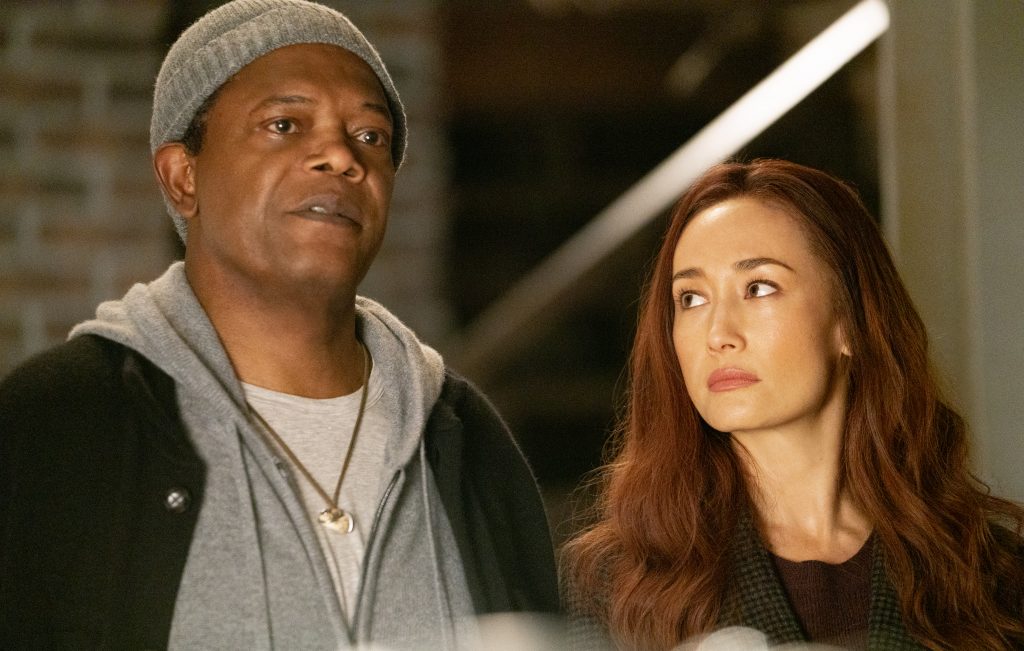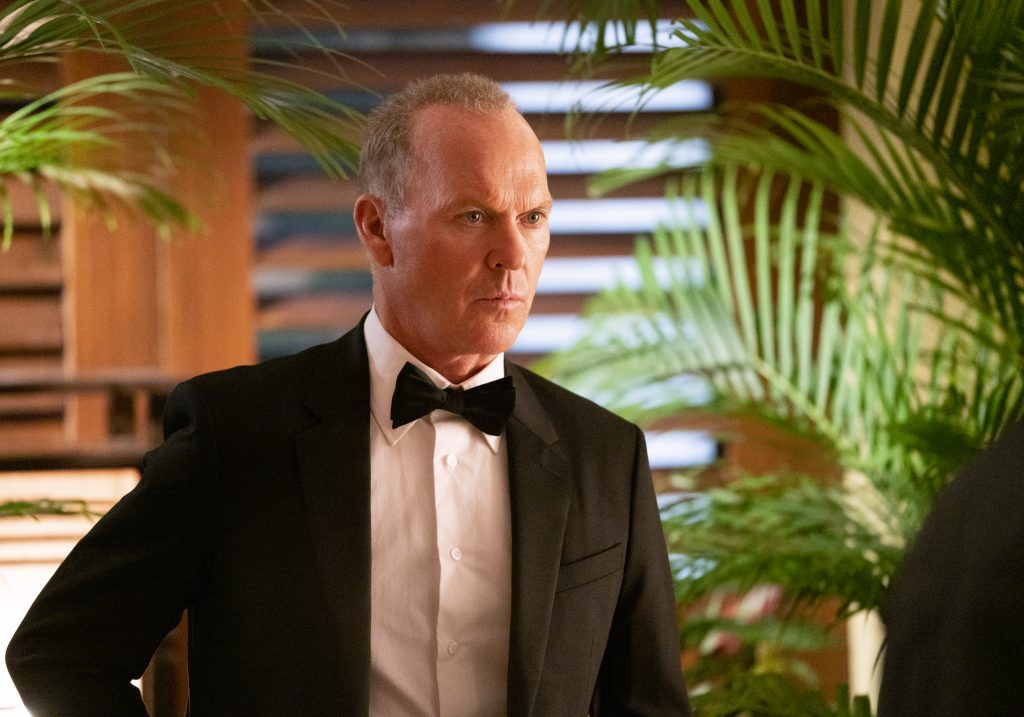August 20, 2021
by Carla Hay

Directed by Martin Campbell
Culture Representation: Taking place in Vietnam, Bucharest and London, the action film “The Protégé” features a predominantly white cast of characters (with some Asians and a few African Americans) representing the wealthy, middle-class and people are linked to the criminal underworld.
Culture Clash: A skilled assassin is out for her revenge when she finds out that her mentor has been murdered.
Culture Audience: “The Protégé” will appeal primarily to people who don’t mind watching formulaic and derivative action flicks.

“The Protégé” is as unimaginative as its title. What could have been a next-level action showcase for star Maggie Q is instead a boring and idiotic retread of so many other movies about assassins out for revenge. The “mystery” and “intrigue” storyline in this movie is almost non-existent, especially when a completely unbelievable plot twist is revealed.
And that begs the question: Why was this movie even made? It seems like a bunch of men (the producers, writer and director of “The Protégé” are all men) just wanted to throw their money around so that they could see Maggie Q (or whichever actress would end up getting the role) in tight clothing while she’s toting a gun and other weapons. There is no interesting plot; it’s just fight scenes at various locations.
Did any of “The Protégé” filmmakers ever see the 2011 American movie “Hanna” or the 2017 South Korean film “The Villainess”? It sure seems that way, because “The Protégé” borrows heavily from the plots of both assassin action films. “Hanna” is about the title character getting trained as an assassin as an underage child. “The Villainess” (which was inspired by 1990’s “La Femme Nikita”) is about a female assassin who witnessed her father getting murdered when she was hiding in a room as a child. “Hanna” and “The Villainess” are infinitely superior to “The Protégé,” which thinks that a few intricate stunts can make up for a weak and nonsensical plot.
In “The Protégé” (directed by Martin Campbell and written by Richard Wenk), Maggie Q plays Anna, an assassin who is originally from Da Nang, Vietnam. She became orphaned in 1991, when she was 11 years old, when she witnessed her family getting murdered while she hid somewhere in the home. It’s eventually revealed in a flashback that an American soldier named Moody (played by Samuel L. Jackson) found Anna hiding in an armoir in the home, and he decided to raise her without formally adopting her.
Moody’s time in the military ended, and he became an assassin who trained Anna on his killer techniques. He’s described in the film as a “legendary” assassin, yet he makes a lot of dumb mistakes and nonsensical decisions that no so-called “professional” would make. A lot of time is wasted in this movie jumping from location to location, with empty-headed fight scenes that are intended to distract from a plot that barely exists.
An an early sequence in “The Protégé” takes place in the Romanian capital of Bucharest, where a ruthless crime lord named Don Preda (played by Velizar Binev) is infuriated because his adult son Vali (played by George Pistereanu) has been kidnapped. By the way, Don has the nickname Donald the Butcher of Bucharest, as if that’s supposed to make viewers of this movie terrified That nickname just sounds like someone who could be a local butcher at a grocery store.
Anna and Moody are in Bucharest around the time that Vali was kidnapped. Some vicious fighting ensues, and some people get killed. Anna and Moody are then seen in London, where Maggie has a cover identity working as a sales clerk in a boutique bookstore that sells rare publications. It’s supposed to make her look like a smart character, but it’s all for nothing because this is a very dumb movie.
For reasons that are never really explained, Moody owns the bookstore. And he’s given the deed to Anna. It’s a foreshadowing that he thinks he’s going to die soon, but Anna appears too dense to notice this clue. To portray a tender “mentor/protégé” moment, the film has Anna and Moody celebrating his birthday by themselves. Anna gives him a gift that Moody doesn’t expect but is delighted to get: a 1958 Gibson Flying V guitar. The guitar becomes a plot device later in the movie.
One day, a mysterious and wealthy American businessman named Michael Rembrandt (played by Michael Keaton) goes into the bookstore because he says that he’s looking for a rare book. Anna recommends a book of poetry by Edgar Allan Poe. But by the way that Michael looks at Anna, it’s obvious he’s not really interested in any rare books. Sure enough, he asks Anna on a date, and she ends up going to his mansion, where more violent hijinks ensue.
Some other characters come into the mix in this messy and undercooked story. Anna and Moody know an informant named Benny, who works out of the back room of a laundromat. Another underground connection for Anna and Moody is a motorcycle gang leader named Billy Boy (played by Robert Patrick), who doesn’t have a lot of screen time in the movie.
There’s also a deaf, blind and mute man in his early 30s named Lucas Hayes (played by Dimitar Nikolov), whose father Edward Hayes (played by David Rintoul) has been assassinated. The murder of Edward happened after he was indicted for war crimes of illegally selling chemical weapons. There’s a murky subplot of Anna trying to find out what Lucas knows, but the filmmakers seem to make Lucas’ disabilities an absurdly cruel joke on Anna, as if to say: “Good luck finding out witness information from a deaf, blind and mute person.”
At one point in the movie, which can’t make up its mind what storyline it wants to focus on, Anna finds a bloody Moody, lying mutilated in his bathtub. The condition of his body indicates that he was murdered. And that means one thing after that: Anna is out for revenge against whoever killed Moody. Because “The Protégé” filmmakers think that globetrotting will make the movie look better than it really is, Anna ends up in Da Nang again.
There’s something that happens later in the movie which absolutely puts it into garbage filmmaking territory. Without giving away too much information, it’s enough to say that whenever plot twists like this happen, viewers are supposed to believe that medical examiners and coroner reports don’t exist, in order for someone to be declared dead and the cause of death. It’s a very lazy plot twist that makes no logical sense.
Meanwhile, because every cliché movie about a woman who’s an assassin seems to require that she has sex with someone who might or might not be her enemy, you can easily guess what will happen between Anna and Michael. Just like the fight scenes in “The Protégé,” the movie’s sex scene looks too calculated and robotic. This is the movie’s idea of foreplay dialogue, when Michael says to Anna: “Do you want to kill me or fuck me?”
“The Protégé” is the type of awful dreck that has this cringeworthy line that someone utters when pointing a gun at someone and commenting on the gun’s bullets: “I can put two in the back of your head and make a sandwich.” How about you take that sandwich and flush it down the toilet, just like how this movie was made?
All of the well-known actors in the movie (Maggie Q, Jackson, Keaton and Patrick) are just doing bland retreads of characters they’ve played before in better movies. Maggie Q certainly has what it takes to be a major action movie star. And some of the stunts she does in “The Protégé” are impressive.
But you need more than just stunts and action choreography to make a good movie. You need to have dialogue and a story that will make people care about the protagonists and what will happen to them. All the actors are given such dreadful lines that they look like they’re just going through the motions and have no real emotional connections to their character roles. When they’re not in fight scenes, the actors look bored. If “The Protégé” filmmakers didn’t care to make a good movie with such a talented cast, then you shouldn’t care to watch it.
Lionsgate released “The Protégé” in U.S. cinemas on August 20, 2021.


